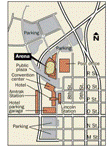Community and Regional Planning Program
Date of this Version
7-2020
Citation
Journal of Soils and Sediments (2020) 20:556–570
doi:10.1007/s11368-019-02390-8
Abstract
Purpose Sediment accumulation has been and continues to be a significant threat to the integrity of the playa wetland ecosystem. The purpose of this study was to determine the vertical depth to the clay soil layer (Bt horizon) and thus to calculate the thickness of sediments accumulated in playa wetlands.
Materials and methods This study used the electromagnetic induction (EMI) survey method, specifically EM38-MK2 equipment, to measure the vertical depth to the clay soil layer at the publicly managed wetlands in the Rainwater Basin, Nebraska, USA.
Results and discussion The results indicated that the depth to the clay soil layer ranges from 21 to 78 cm (n = 279) with a mean sediment thickness of 39 cm. The annual sediment deposition rate since human settlement in the 1860s was calculated to be 0.26 cm year−1. The results provided science-based data to support future wetland restoration planning and the development of decision support tools that prioritize conservation delivery efforts.
Conclusions Our research confirmed that the EMI technique is effective and efficient at determining the depth to the Bt horizon for playa wetlands. Additionally, these results supported previous studies and continue to indicate that a large amount of sediment has accrued in these playa wetlands within the Rainwater Basin area since settlement.Wetland restoration ecologists can use this information to prioritize future wetland restoration work that intends to remove culturally accumulated sediments above the clay soil layer. These findings provided a contemporary summary of wetland soil profile information that is typically used to develop restoration plans. This research also filled the critical knowledge gap about the thickness of the upper soils and the depth to Bt in publicly managed wetlands.


Comments
US govt